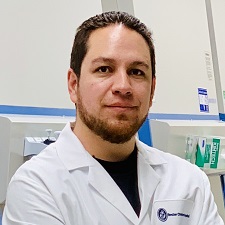One way cancer cells evade immune attack is by constructing a thin material barrier called the glycocalyx on their surface to evade detection and destruction by surveilling immune cells. Tiny changes in the glycocalyx thickness, as small as 10 nanometers, can affect the anti-tumor activity of immune cells, including CAR T cells. Dr. Park’s [Merck Fellow] goal is to develop strategies to endow CAR T cells with the ability to penetrate the glycocalyx barrier in solid tumors such as breast cancer and glioblastoma. These strategies will increase the effectiveness of CAR-T cell therapy against solid tumors by overcoming a significant mechanism of immune cell evasion. Dr. Park received his PhD from Cornell University, Ithaca and his BS from Korea Advanced Institute of Science and Technology, Daejeon.


Understanding how brain cells communicate at synapses—the junctions where neurons connect—is essential for understanding how the brain functions in both health and disease. Dr. Wang's [National Mah Jongg League Fellow] project aims to develop new tools to explore these intricate synaptic connections. Using spatially resolved RNA sequencing techniques, Dr. Wang can identify which genes are active in specific parts of individual neurons within intact brain slices. Additionally, she is creating novel tracers that can map neuronal connections without the toxicity and limitations of current methods. These advancements will not only enhance our understanding of normal brain development and function but also shed light on neurological disorders and brain cancers, such as gliomas, where cancer cells exploit synapses for tumor growth. This research holds the promise of revealing new therapeutic targets and strategies, potentially leading to improved treatments for various brain conditions.

A feared complication of malignant solid tumors is the development of brain metastases (BM), for which current treatments are limited and morbidity is high. While precision medicine approaches for BM have recently demonstrated promise, many patients are not able to benefit from this treatment approach as molecular analysis of BM tissue is not usually feasible. To address this obstacle, Dr. Kim [William G. Kaelin, Jr., MD, Physician-Scientist] will apply genomic profiling and deep learning methods to a rich dataset comprised of BM tissues, patient-matched brain MRIs, and cell-free DNA samples to develop techniques that reveal therapeutic targets within a patient’s BM. He hopes to identify ways to non-invasively characterize oncogenic drivers for a BM or monitor tumor evolution. These findings will demonstrate the potential of using algorithmic tools in the clinic to augment clinical decision-making and unlock opportunities for widespread application of precision medicine for BM.

Dr. Fang [HHMI Fellow] develops multiplexed imaging techniques to illuminate how enhancers control gene expression at a single cell level. Enhancer alterations are widely spread in cancer, but there is limited understanding of how these enhancers vary between single cells and relate to oncogene expression. Dr. Fang will generate single-cell regulatory networks to investigate how enhancer activities are disrupted in IDH-mutant cancers. The proposed work may help identify enhancer-based therapeutic targets for cancer treatment in the future.

Dr. Orellana Vinueza is investigating whether changes that modify the shape, stability and function of transfer RNAs (tRNAs) play a role in the development of cancer. The tRNA molecules are involved in the process that translates messenger RNA into a protein. Dr. Orellana Vinueza focuses on a tRNA methyltransferase complex that malfunctions in glioblastoma and liposarcoma. He will assess how alterations in the activity of this enzyme affect global patterns of methylation in normal and human cancer cells. Methylation is the process that controls the timing and amount of proteins that are produced in cells. Understanding how this process breaks down may help decipher the mechanisms that drive cancer and guide the development of new treatments.
